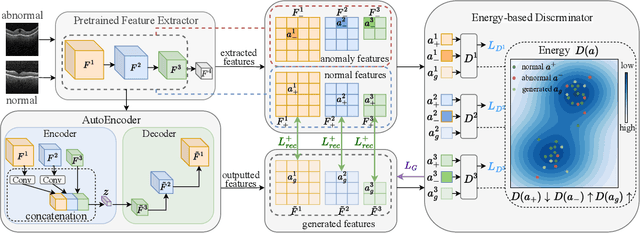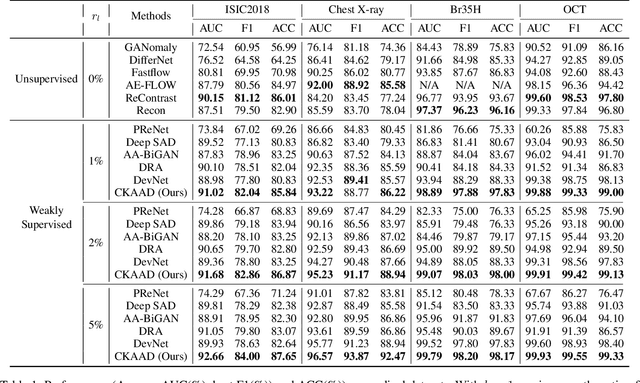Qingqing Fang
Boosting Fine-Grained Visual Anomaly Detection with Coarse-Knowledge-Aware Adversarial Learning
Dec 17, 2024



Abstract:Many unsupervised visual anomaly detection methods train an auto-encoder to reconstruct normal samples and then leverage the reconstruction error map to detect and localize the anomalies. However, due to the powerful modeling and generalization ability of neural networks, some anomalies can also be well reconstructed, resulting in unsatisfactory detection and localization accuracy. In this paper, a small coarsely-labeled anomaly dataset is first collected. Then, a coarse-knowledge-aware adversarial learning method is developed to align the distribution of reconstructed features with that of normal features. The alignment can effectively suppress the auto-encoder's reconstruction ability on anomalies and thus improve the detection accuracy. Considering that anomalies often only occupy very small areas in anomalous images, a patch-level adversarial learning strategy is further developed. Although no patch-level anomalous information is available, we rigorously prove that by simply viewing any patch features from anomalous images as anomalies, the proposed knowledge-aware method can also align the distribution of reconstructed patch features with the normal ones. Experimental results on four medical datasets and two industrial datasets demonstrate the effectiveness of our method in improving the detection and localization performance.
AnomalySD: Few-Shot Multi-Class Anomaly Detection with Stable Diffusion Model
Aug 04, 2024



Abstract:Anomaly detection is a critical task in industrial manufacturing, aiming to identify defective parts of products. Most industrial anomaly detection methods assume the availability of sufficient normal data for training. This assumption may not hold true due to the cost of labeling or data privacy policies. Additionally, mainstream methods require training bespoke models for different objects, which incurs heavy costs and lacks flexibility in practice. To address these issues, we seek help from Stable Diffusion (SD) model due to its capability of zero/few-shot inpainting, which can be leveraged to inpaint anomalous regions as normal. In this paper, a few-shot multi-class anomaly detection framework that adopts Stable Diffusion model is proposed, named AnomalySD. To adapt SD to anomaly detection task, we design different hierarchical text descriptions and the foreground mask mechanism for fine-tuning SD. In the inference stage, to accurately mask anomalous regions for inpainting, we propose multi-scale mask strategy and prototype-guided mask strategy to handle diverse anomalous regions. Hierarchical text prompts are also utilized to guide the process of inpainting in the inference stage. The anomaly score is estimated based on inpainting result of all masks. Extensive experiments on the MVTec-AD and VisA datasets demonstrate the superiority of our approach. We achieved anomaly classification and segmentation results of 93.6%/94.8% AUROC on the MVTec-AD dataset and 86.1%/96.5% AUROC on the VisA dataset under multi-class and one-shot settings.
3D PETCT Tumor Lesion Segmentation via GCN Refinement
Feb 24, 2023Abstract:Whole-body PET/CT scan is an important tool for diagnosing various malignancies (e.g., malignant melanoma, lymphoma, or lung cancer), and accurate segmentation of tumors is a key part for subsequent treatment. In recent years, CNN-based segmentation methods have been extensively investigated. However, these methods often give inaccurate segmentation results, such as over-segmentation and under-segmentation. Therefore, to address such issues, we propose a post-processing method based on a graph convolutional neural network (GCN) to refine inaccurate segmentation parts and improve the overall segmentation accuracy. Firstly, nnUNet is used as an initial segmentation framework, and the uncertainty in the segmentation results is analyzed. Certainty and uncertainty nodes establish the nodes of a graph neural network. Each node and its 6 neighbors form an edge, and 32 nodes are randomly selected for uncertain nodes to form edges. The highly uncertain nodes are taken as the subsequent refinement targets. Secondly, the nnUNet result of the certainty nodes is used as label to form a semi-supervised graph network problem, and the uncertainty part is optimized through training the GCN network to improve the segmentation performance. This describes our proposed nnUNet-GCN segmentation framework. We perform tumor segmentation experiments on the PET/CT dataset in the MICCIA2022 autoPET challenge. Among them, 30 cases are randomly selected for testing, and the experimental results show that the false positive rate is effectively reduced with nnUNet-GCN refinement. In quantitative analysis, there is an improvement of 2.12 % on the average Dice score, 6.34 on 95 % Hausdorff Distance (HD95), and 1.72 on average symmetric surface distance (ASSD). The quantitative and qualitative evaluation results show that GCN post-processing methods can effectively improve tumor segmentation performance.
 Add to Chrome
Add to Chrome Add to Firefox
Add to Firefox Add to Edge
Add to Edge